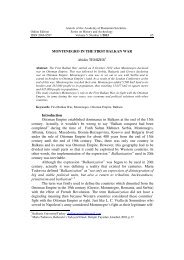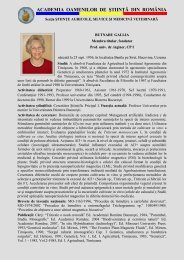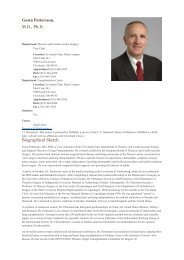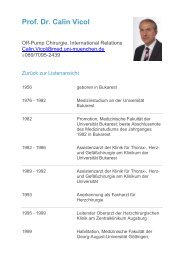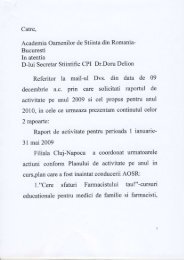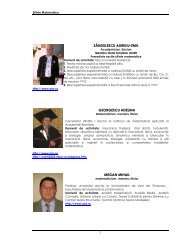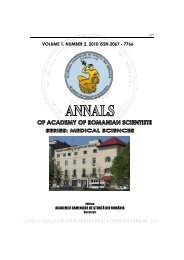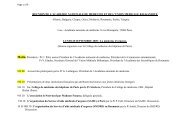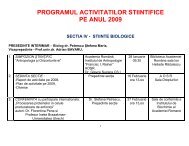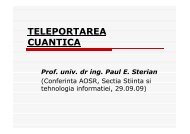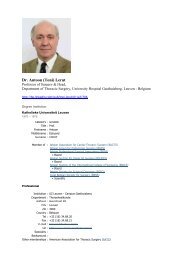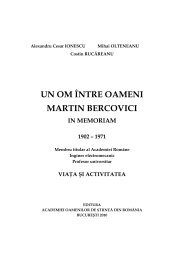Volume 3 nr 1 / 2011 - Academia Oamenilor de Stiinta din Romania
Volume 3 nr 1 / 2011 - Academia Oamenilor de Stiinta din Romania
Volume 3 nr 1 / 2011 - Academia Oamenilor de Stiinta din Romania
- No tags were found...
You also want an ePaper? Increase the reach of your titles
YUMPU automatically turns print PDFs into web optimized ePapers that Google loves.
The Study of Heavy Metal from Environmental Samples by Atomic Techniques 37They fall between the best vegetables and animal protein source. Mushrooms areconsi<strong>de</strong>red as source of proteins, vitamins, fats, carbohydrates, amino acids, andminerals [4]. The energy value varies accor<strong>din</strong>g to species, which is about equalto that of an apple. Many studies have been <strong>de</strong>monstrated the fact that somemushrooms species (Pleurotus species for examples) are useful in somecombination to cure headache, stomach aliments, colds, fever, asthma and highblood pressure [4]; other species are recommen<strong>de</strong>d to diabetic and anemicpersons, owing to their low carbohydrate and high folic acid content. Somemushrooms are reputed to possess anti-allergic, anti-cholesterol, anti-tumour andanti-cancer properties [5, 6].Compared to green plants, mushrooms can build up large concentrations of someheavy metals, particularly cadmium, mercury, copper and lead [7]. This suggeststhat mushrooms possess a very effective mechanism that enables them readily totake up heavy metals from soil [8]. In many studies [7-10] the concentrations ofheavy metals have been observed in the fruiting bodies of different mushroomscollected adjacent to heavy metal smelters, landfills of sewage sludge, emissionarea. Basidiomycetes are generally capable of accumulating heavy metals and thenbecome their source in food chain [11]. Moreover, a lot of mushrooms speciesaccumulate radioactive isotopes of cesium [1].Consumption of wild growing mushrooms has been preferred to eating ofcultivated fungus in <strong>Romania</strong> (e.g. Armillariella mellea, Amanita vaginata,Amanita rubescens). But, the knowledge of the nutritional value of wild growingmushrooms has been limited when compared with other vegetables. It seems thatmushrooms are still much more to offer, but is necessary to concentrate all studiesfor establishing a real metabolic features for one species in the view to promote itas hyperacculator or bioindicators for one metal species.Different heavy metals such as As, Cd, Ni, Hg, accumulated in high concentrationin mushrooms are toxic for the peoples; on the other hand many elements areessential for the human metabolism, such as Fe, Zn, Mn, Cu, Cr, Se, but in lowconcentrations, because they are enzyme activators. These essential elementsbecome toxic in the measure of increasing their concentrations too much. It is wellknow that the content of heavy metals are related to species of mushrooms,collecting area of the sample, age of fruiting bodies and distance from any sourceof pollution.The aim of this work was to <strong>de</strong>termine the heavy metal content of the fruitingbodies of four species eight wild mushrooms (Amanita vaginata, Amanitarubescens, Amanita phalloi<strong>de</strong>s, Armillariella mellea, Armillariella tabescens,Agaricus campestris, Hypholoma fasciculare, Hypholoma pudorinus) and soilsamples, collected from ten forest sites of Dambovița county, <strong>Romania</strong>.Copyright © Editura Aca<strong>de</strong>miei <strong>Oamenilor</strong> <strong>de</strong> Știință <strong>din</strong> România, <strong>2011</strong>Watermark Protected



